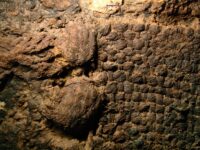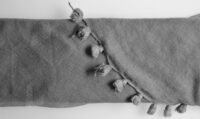Two extremely rare early Iron Age swords have been unearthed in Andechs, southern Germany. They were crafted in the Hallstatt period, the 8th century B.C., and are among the oldest iron swords ever discovered in southern Germany.
The swords were discovered in March during construction of a new firehouse in Andechs, Bavaria. Crews had only barely broken ground when they encountered two swords and fragments from three ceramic vessels less than 16 inches under the surface. The objects were grave goods, each sword buried in a separate grave with cinerary remains. The remains were  concentrated in certain areas, suggesting they were originally placed in an organic container like a cloth bag that was then buried next to the weapons. Another six burials were found at the site, with grave goods including a bowl-head pin and bronze jewelry.
concentrated in certain areas, suggesting they were originally placed in an organic container like a cloth bag that was then buried next to the weapons. Another six burials were found at the site, with grave goods including a bowl-head pin and bronze jewelry.
The swords straddle an important transitional stage from the use of bronze to the use of iron in weapons. They are both made of iron, but the earlier one was made in the shape and style of a bronze sword. The later one, made in the same century, had an adapted design to take advantage of the stronger, more stable metal.
The swords are 76 and 66 centimeters long and six centimeters wide. While the shorter one was probably mainly used as a stabbing weapon in man-to-man combat, the longer and heavier one was more suitable as a stabbing weapon that the fighter could wield from above – for example from horseback.
In the Bavarian State Office for the Preservation of Monuments in Munich, a team of restorers cleaned the swords with micro-fine blasting technology and examined them more closely. The blades are partially heavily corroded, the handles are missing. However, the restorers were able to identify traces of horn on one of the so-called handle tongues, which suggests a handle made of this material. Two of the four rivets that held the horn plates on the grip tongue are still preserved on the handle. Because no such remains of attachment can be seen on the other sword, restorers and archaeologists assume that the hilt was attached with a resin adhesive. It is no longer possible to trace what material it was made of. […]
The remains of a multi-layer linen weave textile were also found on the two blades, as well as the remains of a cord that must have been wrapped around it in several places. The weapons were presumably wrapped in cloth and given to the dead.


The Holy Mountain of Andechs was already inhabited in prehistory and early history. Coin finds from the mountain slope and from the immediate surroundings seem to indicate that there was a Roman military station on the elevation, in connection with the conquest of the Alpine foothills under Augustus.
The name of the village was first mentioned around 1050AD as “Andehsa” and derives from the Roman area measure “andecena”, which was used in German as “anzing” until modern times. In the Middle Ages, Andechs Castle was the ancestral seat of the Counts of Andechs and Dukes of Merania, who died out in 1248.
After a legendary recovery of the lost treasure of relics of the Counts of Andechs in 1388, Andechs revived as a place of pilgrimage and experienced a new flowering. In 1455, the monastery was founded on the Holy Mountain. Maybe, the mountain has been “holy” already in the Iron Age. In Frieding, where apparently the swords have been found, there where Iron Age burial mounds and a neolithic flint axe discovered.
The area around Lake Starnberg and Lake Ammer was densely populated in Roman times. Thus, a road lead from Gauting to the Frieding meadows to Kempten (Καμβοδουνον / Campodunum). The Romans burned bricks in a village called “Blattenstein” (Frieding) and established a “planting school” there.
:hattip:
——–
1 anzing = 0.5 bavarian morgen. A morgen was a unit of measurement of land area in Germany, the Netherlands, Poland, Lithuania and the Dutch colonies, including South Africa and Taiwan. The size of a morgen varies from 1⁄2 to 2+1⁄2 acres (2,000 to 10,100 m2). It was also used in Old Prussia, in the Balkans, Norway and Denmark, where it was equal to about two-thirds acre (2700 m^2)
——–
The andecena or andecinga was a Roman acreage measure of 16000 Roman square feet or about 1400 square meters in area. “Andecenas legitimas hoc est perticam 10 pedes habentem 4 perticas in transverso et 40 in longo.”, according to the Lex Baiuvariorum (1, 13) from the 6th to 8th centuries. The andecena measured in width 4 rods (pertica) of 10 Roman feet each (= 0.296 m), thus 40 Roman feet or 11.84 m, but in length 40 rods or 400 Roman feet = 118.4m.
——–
cf.:
en.wikipedia.org/wiki/Klosterbrauerei_Andechs
en.wikipedia.org/wiki/Counts_of_Andechs
The Roman poet Ovid on the proverbial hardness of Noric steel in his “Metamorphoses” (Bk. 14, 711-715)
“..harder than iron tempered by Noric fire was Anaxarete towards the advances of Iphis..”
The Celtic kingdom of “Noricum” was located to the east of Andechs. Presumably, they traded to Italy as well as to Bavaria.
—-
saevior illa freto surgente cadentibus Haedis,
durior et ferro, quod Noricus excoquit ignis,
et saxo, quod adhuc vivum radice tenetur,
spernit et inridet, factisque inmitibus addit
verba superba ferox et spe quoque fraudat amantem.
—-
“the longer and heavier one was more suitable as a stabbing and stabbing weapon” – that’s a lot of stabbing! A very stabby weapon.